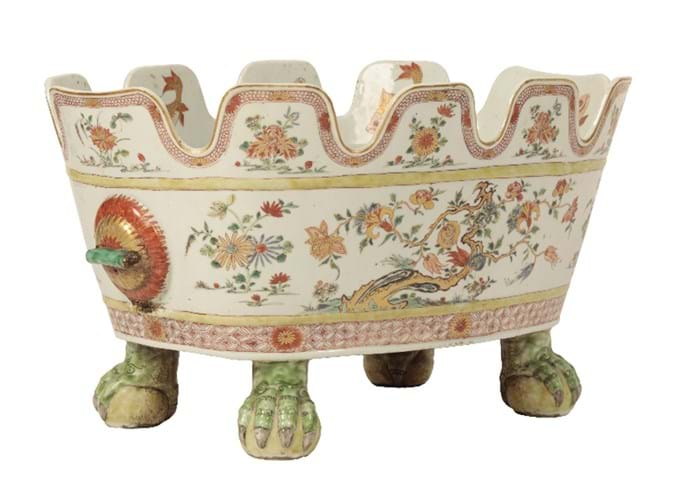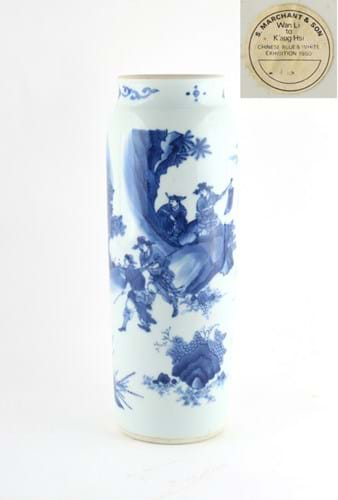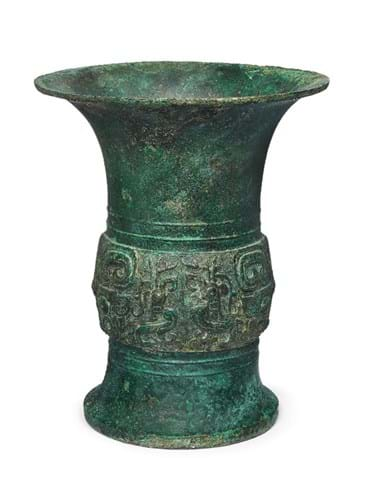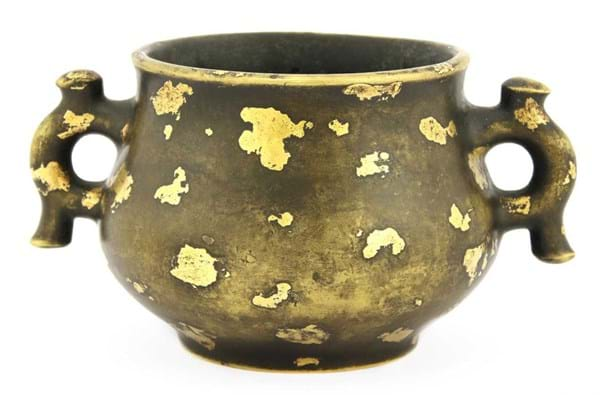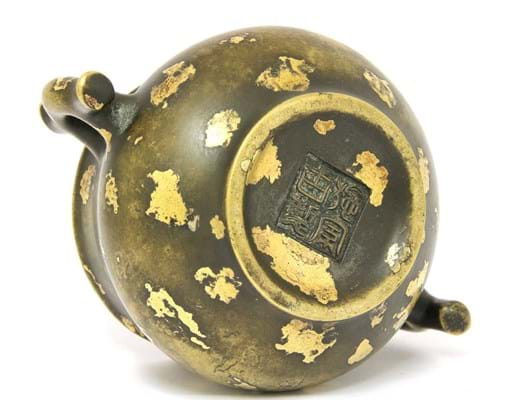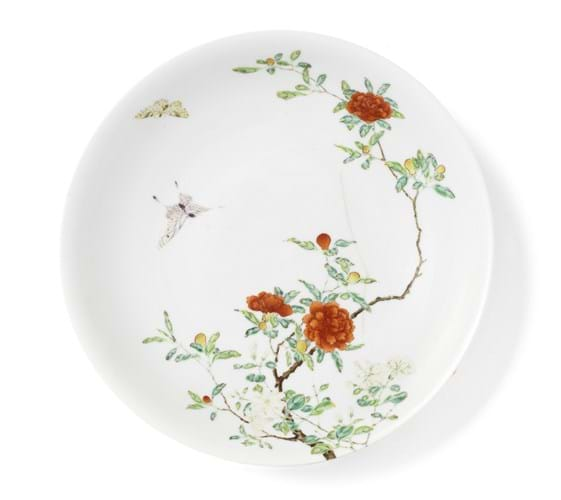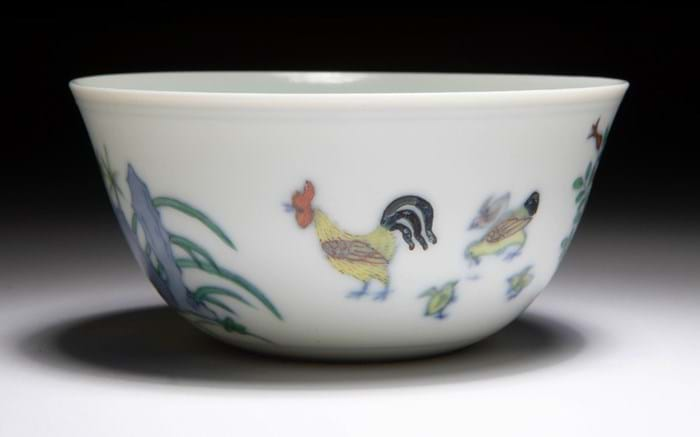1. Kangxi porcelain monteith – £90,000
It is thought that the earliest Chinese porcelain monteith appeared c.1715, coinciding with the establishment of the East India Company’s factory in Canton.
The design of these, first made in silver in the 1680s, was perfectly suited to the cooling of wine bottles or wine glasses with the bottle necks or stems held securely within the shaped rim. The deep base could then be filled with chilled water.
The large size of this example dating from the end of the reign of the emperor Kangxi (1661-1722) suggest it was most likely to have been made for bottles rather than glasses.
The exotic famille verte decoration of flowers and leaping carp combined with the European form would have made these extremely desirable among the high society of the time. A similar pair, thought to have been acquired by George IV for Brighton Pavilion, now reside in the dining room at Clarence House.
This one came for sale at Duke’s of Dorchester from the family of Major Sir Alfred Hammond Aykroyd 2nd Baronet of Lightcliffe, Yorkshire (1894-1965). Duke’s expected it to bring £40,000-60,000 on November 9 and were not disappointed.
The hammer price was £90,000.
2. Blue and white sleeve vase – £46,000
Semley Auctions in Dorset sold the Martin Robert Morland (1933-2020) collection of Chinese ceramics on November 7. Morland, who served in the Grenadier Guards before becoming a diplomat, bought mainly Qing blue and white wares from a range of dealers in the 1970s and 80s.
Many of the items were sold complete with original receipts.
This Transitional period blue and white sleeve vase, 10in (25cm) high, decorated with a continuous scene of a hunting party in mountainous landscape between incised anhua bands, has a label for London dealership Marchant. It was purchased there on July 15, 1980 for £4500.
Estimated at £10,000-15,000, it sold at £46,000.
It was during the so-called Transitional period, the era of protracted civil war that marked the transition from Ming to Qing, that the centuries-old system of court-sponsored porcelain manufacture at Jingdezhen collapsed. In its place came new customers – the literati, the merchant class and foreign trading companies from Europe and Japan – and new wares catering to their tastes.
Among the most recognisable products are these tall cylindrical vessels freely decorated with extravagant landscapes or scenes from popular literature. As indicated by the price paid for this piece 40 years ago, they were once considered the epitome of old European collecting taste.
3. Ancient Chinese wine vessel – £42,000
Albert (1927-2018) and Leonie van Daalen-Roell (1930-2018) were descendants of Dutch families who followed family tradition in amassing an extensive art collection.
On November 11 Roseberys offered 50 lots from their estate which included items ranging from archaic bronzes to Tang ceramics and later export porcelain.
This Western Zhou dynasty ritual wine vessel (Zun) decorated with two taotie masks and two pairs of confronting dragons was used for making offerings during religious ceremonies or ancestral rituals. The inscription to the interior of this vessel consists of a clan sign followed by fu yi. This is a dedication which means 'dedicate this vessel to' Fu Yi (Father Yi).
Bought by Albert and Leonie van Daalen-Roell from London dealer Ben Janssens Oriental Art in 2002, it had expectations of £50,000-£80,000 but sold a little short of this level at £42,000.
4. Qing incense burner – £105,000
Sworders Asian art sale in Stansted Mountfitchet on November 6 included this ‘splashed’ gilt-bronze incense burner from the Qing (1644-1911) period.
It is among a small number of Ming style bronzes that carry a four-character mark Shiji Guzhi mark. This rare inscription meaning ‘The family Shi had the censor commissioned in the archaic style’ references one of eight prominent families of Tianjin whose ancestral home is today an important historical site.
Estimated at £4000-6000, it sold to a buyer based in Hong Kong for £105,000.
5. Yongzheng dish – £170,000
One of the unexpected highpoints of Bonhams’ Fine Chinese Art sale on November 5 was this 8in (20cm) Yongzheng mark and period famille rose ‘butterflies and peonies’ dish.
This pattern, known as ‘guozhi’ or overextended branches (the blossoming peony branches extend over the rim of the dish into the interior), is also a homophone of the phrase ‘guozhi’, meaning prolonged peace under good government. It was first developed towards the end of the Ming dynasty, and later became popular during the Yongzheng reign.
Despite its condition issues, that include a crack to the well, it sold at £170,000 (estimate £3000-5000).
The dish was sold by Bluett & Sons in the 1920s and again at Sotheby's in 1951 when it was bought by Bradford solicitor Robert Stanley Hope Smith (1910-79).
He and his wife Joan began collecting famille rose and famille verte porcelain pieces in the immediate post-war years and were elected members of the Oriental Ceramic Society in 1959.
Working on a relatively modest budget, they acquired pieces from well-known collections formed by Lord Cunliffe, Montague Meyer, Leonard Gow, along with OCS exhibition pieces. What may have not been key pieces for them became the core of this collection.
Broken pieces were quite acceptable: kintsugi (the Japanese art of repairing broken pottery by mending the areas of breakage with lacquer dusted or mixed with powdered gold, silver, or platinum) was key to Robert Stanley Hope Smith’s passion, for he had suffered from polio as a child and walked with a cane. Joan Hope Smith died in 2000 and the collection has since been in storage.
6. Doucai ‘chicken cup’ – £80,000
Lyon & Turnbull’s Fine Asian Works of Art in London on November 5 featured this 3in (8cm) diameter doucai ‘chicken cup’. It has an apocryphal 15th century (Chenghua) mark but was of considerable age – probably made in the Kangxi period.
It came by descent from a private English collection in Bath and was probably acquired in the 19th or early 20th century.
Pitched at £18,000-24,000, it took £80,000.


